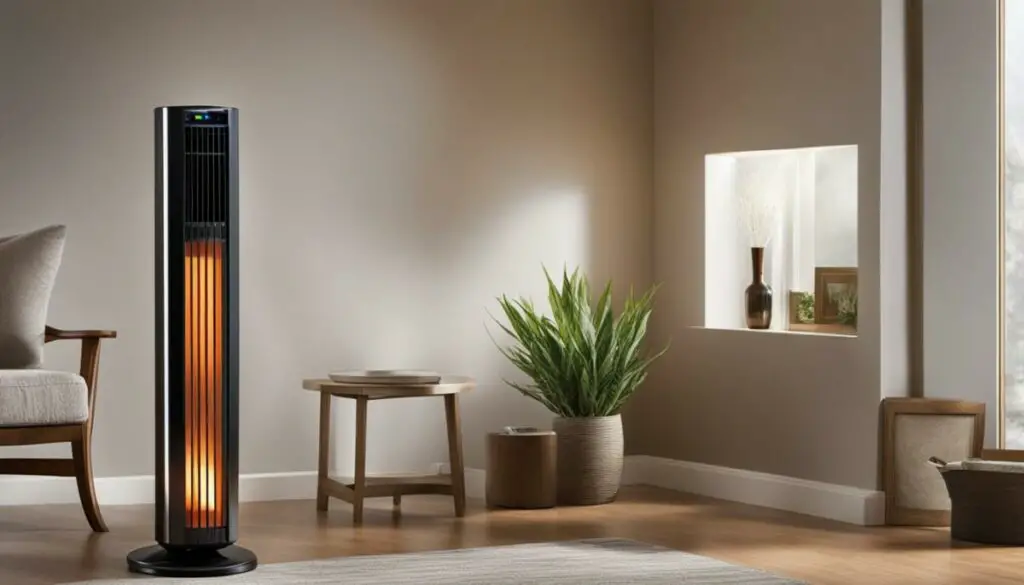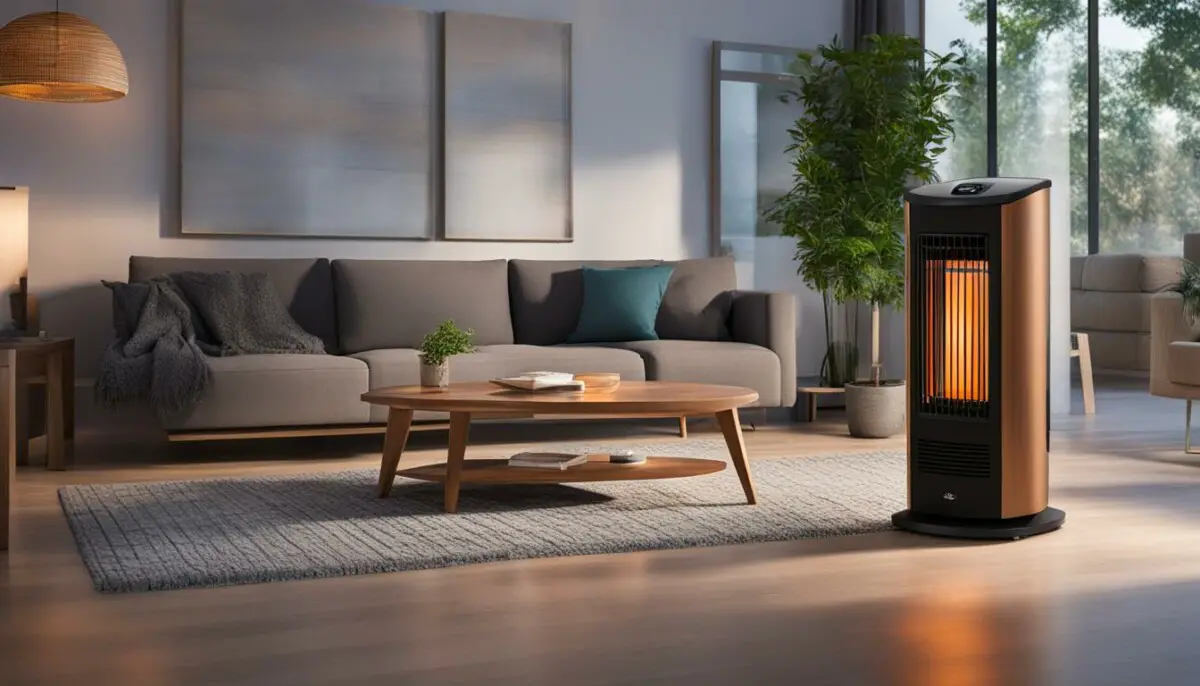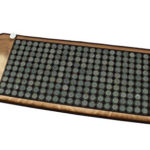Last Updated on 6 months by Francis
Infrared heaters have gained popularity as an affordable and efficient heating option. However, safety concerns often arise when it comes to their usage. Are infrared heaters safe? In this article, we will delve into the truth behind the safety of infrared heaters and provide you with the information you need to make an informed decision.
Contents
Key Takeaways:
- Infrared heaters emit infrared radiation, which can effectively warm up spaces without harmful emissions.
- Prolonged exposure to infrared radiation can be harmful to the eyes, but as long as they are used with caution, infrared heaters are generally safe.
- Choosing reputable brands and following safety guidelines can further enhance the safety of using infrared heaters.
- Infrared heaters offer benefits such as cost-effectiveness, energy efficiency, and improved air quality.
- Advanced technologies are continuously improving the safety and efficiency of infrared heaters, making them a promising heating solution for the future.
How Infrared Heaters Work
Infrared heaters offer several benefits over conventional heaters, making them a popular choice for many consumers. One of the main advantages of infrared heaters is how they work to provide heat. Unlike traditional heaters that heat the air in a room, infrared heaters directly heat objects and people in their path.
These heaters emit infrared waves, which are similar to the sun’s rays. These waves can be absorbed by our bodies and the objects around us, creating a warm and cozy environment. By focusing on heating objects rather than the air, infrared heaters are able to provide quick and targeted warmth.
In addition to their heating capabilities, infrared heaters also have another significant advantage: they do not emit harmful gases or chemicals into the air. This makes them a safer and more environmentally friendly option compared to other types of heaters. With infrared heaters, you can enjoy warmth and comfort without worrying about the negative impacts on your health or the environment.
| Infrared Heaters | Other Heaters | |
|---|---|---|
| Heating Method | Directly heats objects and people | Heats the air in the room |
| Emissions | Do not emit harmful gases or chemicals | May emit gases or chemicals |
| Efficiency | Energy-efficient, as they heat targeted areas | May require more energy to heat the entire room |
| Environmental Impact | Environmentally friendly | May have a higher carbon footprint |
Overall, infrared heaters provide numerous benefits, including efficient heating, safety, and environmental friendliness. Their unique heating method and lack of emissions make them an excellent choice for anyone looking for a cost-effective, energy-efficient, and safe heating solution.
Understanding Infrared Radiation
Infrared radiation is a natural form of electromagnetic radiation that is emitted by the sun and infrared heaters. It is different from ultraviolet (UV) radiation, which can be harmful to the skin and eyes. Infrared heaters do not emit UV rays or carbon monoxide, making them safe for indoor use. While prolonged exposure to high levels of infrared radiation can potentially cause cellular damage, our bodies have natural protective mechanisms to minimize this risk.
When it comes to health concerns related to infrared heaters, it’s important to understand that they do not emit carbon monoxide, a toxic gas that can be produced by other types of heaters. Infrared heaters primarily emit infrared radiation, which is a natural and safe form of heat. It’s important to note that the level of infrared radiation emitted by infrared heaters is significantly lower than the levels that could cause harm.
“Infrared heaters primarily emit infrared radiation, which is a natural and safe form of heat.”
Furthermore, infrared radiation does not penetrate the skin as deeply as some other forms of radiation, such as X-rays. The majority of the energy from infrared radiation is absorbed by the skin and does not penetrate beyond the surface. This means that the risk of cellular damage from infrared heaters is minimal, especially when they are used according to the manufacturer’s guidelines and safety recommendations.
| Myth | Fact |
|---|---|
| Infrared heaters emit harmful levels of radiation. | Infrared heaters emit safe levels of infrared radiation, similar to natural sunlight. |
| Infrared heaters produce carbon monoxide. | Infrared heaters do not emit carbon monoxide. |
| Prolonged exposure to infrared radiation can cause serious health issues. | Prolonged exposure to low levels of infrared radiation from infrared heaters is unlikely to cause harm. |
The Safety of Infrared Heaters for Human Health
When it comes to the safety of infrared heaters for human health, there are a few considerations to keep in mind. Overall, infrared heaters are generally safe to use and do not pose significant health risks. However, it is important to use them responsibly and follow safety guidelines to minimize any potential hazards.
While infrared heaters do not emit harmful substances like carbon monoxide and do not generate excessive radiation, certain individuals should exercise caution when using these heaters. Pregnant women should avoid prolonged close proximity to infrared heaters, as they may be more vulnerable to radiation exposure. Additionally, individuals with heart problems should also be mindful and limit their exposure to infrared radiation.
It’s important to note that our bodies have natural protective mechanisms to minimize the potential risks associated with infrared radiation. The key is to use infrared heaters in moderation and maintain a safe distance from the heater. By doing so, you can enjoy the benefits of infrared heating while minimizing any potential health concerns.
The Importance of Responsible Use
Responsible use of infrared heaters involves following safety guidelines and taking necessary precautions. It is crucial to read and follow the manufacturer’s instructions to ensure proper installation and usage. Additionally, maintaining proper ventilation in the room where the heater is being used can help prevent the buildup of heat and maintain air quality.
Regular inspections of the heater for any issues should also be conducted to ensure its safe operation. If you notice any abnormalities or suspect a malfunction, it is recommended to seek professional assistance to address the problem promptly.
Infrared Heaters and COVID-19 Prevention

Infrared heaters have gained popularity not only for their heating capabilities but also for their potential in reducing the transmission of COVID-19. By maintaining a constant temperature in indoor spaces, infrared heaters can help minimize the survival and transmission of the virus. This can be attributed to the fact that high temperatures can create an environment where viruses have a harder time surviving.
Unlike conventional heating methods, infrared heaters provide a reliable and cost-effective option for creating a warm and comfortable environment without emitting harmful substances. They operate by emitting infrared waves that are similar to the sun’s rays, which can be absorbed by the body and objects in the room. This direct transfer of heat eliminates the need for heating the air, reducing the circulation of airborne particles that may carry the virus.
In addition to maintaining temperature, infrared heaters can also help maintain humidity levels. Research suggests that maintaining optimal humidity levels can further aid in reducing the spread of airborne viruses, as viruses tend to thrive in low humidity environments. By incorporating an infrared heater into your indoor space, you can create a comfortable environment that promotes both warmth and humidity, contributing to the prevention of COVID-19 transmission.
Types of Infrared Heaters

Infrared heaters come in different types, each with its own unique benefits and applications. Understanding the various types can help you choose the safest and best infrared heater for your needs.
Near-Infrared Heaters
Near-infrared heaters emit shorter wavelengths of infrared radiation, which can be absorbed directly by the skin. They provide immediate warmth and are often used for therapeutic purposes, such as muscle relaxation and pain relief. These heaters are commonly found in saunas and beauty salons.
Medium-Infrared Heaters
Medium-infrared heaters emit slightly longer wavelengths of infrared radiation. They are commonly used in industrial settings, such as drying paint or curing materials. These heaters can also be used for outdoor heating, such as in patio heaters, as they provide a good balance between direct and ambient heat.
Far-Infrared Heaters
Far-infrared heaters emit longer wavelengths of infrared radiation, which can penetrate deeper into the body, providing a more gentle and comfortable heat. These heaters are commonly used for residential purposes and are considered safe for human use. They are efficient, cost-effective, and provide consistent heat distribution, making them a popular choice for home heating.
Comparing the Types of Infrared Heaters
| Type | Direct Heat | Ambient Heat | Applications |
|---|---|---|---|
| Near-Infrared Heaters | High | Low | Saunas, Beauty salons |
| Medium-Infrared Heaters | Moderate | Moderate | Industrial, Outdoor heating |
| Far-Infrared Heaters | Low | High | Residential, Home heating |
Each type of infrared heater has its own advantages and is suitable for different settings. It is important to choose the right type based on your specific heating needs and preferences. Consider factors such as the desired level of direct heat, ambient heat, and the intended application when selecting the best infrared heater for your space.
Addressing Common Concerns
When it comes to using infrared heaters, there are often concerns about their safety and potential health risks. However, it’s important to understand that infrared heaters are generally safe to use when used responsibly and according to the manufacturer’s guidelines. To address common concerns and provide reassurance, let’s take a closer look at some frequently raised questions regarding the safety of infrared heaters.
Are Infrared Heaters Safe for Human Health?
Infrared heaters are designed to emit infrared radiation, which is a natural and safe form of electromagnetic radiation. Unlike ultraviolet (UV) radiation, which can be harmful to the skin and eyes, infrared radiation is considered to be low-risk and poses minimal health concerns when used correctly. It’s important to note that while infrared heaters themselves are generally safe, it’s essential to use them responsibly and avoid prolonged exposure, especially for individuals who may be more vulnerable, such as pregnant women or those with heart problems.
Do Infrared Heaters Emit Harmful Levels of Radiation?
One common concern is whether infrared heaters emit harmful levels of radiation. The International Commission for Non-Ionising Radiation Protection (ICNIRP) has assessed the safety of infrared heaters and established guidelines to ensure safe usage. As long as the heaters are used and maintained correctly, they emit minimal levels of radiation that are considered safe for human health. It’s important to note that infrared heaters do not emit harmful ultraviolet (UV) radiation or carbon monoxide, making them safe for indoor use.
In conclusion, infrared heaters are generally safe and pose minimal health risks when used responsibly and according to safety guidelines. They provide an efficient and cost-effective heating solution, particularly for indoor spaces. By understanding how infrared heaters work and following recommended usage practices, individuals can enjoy the benefits of these heaters while minimizing any potential health concerns.
Benefits of Infrared Heaters

When it comes to heating your space, infrared heaters offer a wide range of benefits that make them a popular choice among homeowners. Not only are they cost-effective, but they also provide efficient and targeted heat, ensuring maximum comfort. Let’s explore some of the key advantages of using infrared heaters:
1. Cost-effectiveness:
Infrared heaters are known for their energy efficiency, which translates to lower heating costs. Unlike traditional heaters that heat the air, infrared heaters directly warm up objects and people in their vicinity. This targeted approach allows you to stay warm without having to heat the entire room, saving both energy and money.
2. Healthy and Environmentally Friendly:
Infrared heaters operate without burning any fossil fuels or emitting harmful gases or chemicals into the air. They also do not produce any dry air or dust, making them safer for individuals with respiratory issues. Additionally, since they don’t rely on forced air circulation, there’s a reduced risk of allergens and mold spores spreading throughout your space.
3. Improved Air Quality:
Conventional heaters can lead to dry and stuffy air, which can cause discomfort and respiratory issues. Infrared heaters, on the other hand, help maintain humidity levels, keeping the air moist and preventing dryness. By improving air quality, they create a healthier and more comfortable environment for you and your family.
| Benefits | Infrared Heaters | Traditional Heaters |
|---|---|---|
| Energy Efficiency | ✓ | ✗ |
| Targeted Heating | ✓ | ✗ |
| Healthy and Environmentally Friendly | ✓ | ✗ |
| Improved Air Quality | ✓ | ✗ |
“Infrared heaters offer cost-effective and efficient heating, while also promoting better air quality and a healthier living environment.” – HVAC Expert
With their numerous benefits, infrared heaters are indeed an excellent choice for staying warm in a safe and efficient manner. Whether you’re looking to reduce your heating costs or create a more comfortable living space, investing in the best and safest infrared heater can provide you with the warmth and peace of mind you need.
Making Infrared Heaters Safer

Ensuring the safe use of infrared heaters is crucial to protect yourself and your loved ones. By following these safety guidelines, you can enjoy the benefits of infrared heating while minimizing any potential risks.
1. Read and Follow Manufacturer’s Instructions
Before using an infrared heater, carefully read and understand the manufacturer’s instructions. This will help you properly install, operate, and maintain the heater. Pay attention to any safety precautions or warnings provided.
2. Maintain Proper Ventilation
Infrared heaters require adequate ventilation to ensure proper air circulation and prevent the buildup of harmful gases like carbon monoxide. Make sure the heater is placed in a well-ventilated area and ensure that vents or openings are not obstructed.
3. Keep a Safe Distance
To avoid any potential risks, maintain a safe distance between yourself and the infrared heater. It is recommended to keep a distance of at least 3 feet between the heater and any objects or individuals. This helps prevent accidental contact and reduces the risk of burns.
4. Limit Prolonged Exposure
While infrared heaters are generally safe, it is important to avoid prolonged exposure to the emitted radiation. Limit the time spent near the heater, especially if you have sensitive skin or underlying health conditions. If you start feeling uncomfortable or experience any adverse effects, move away from the heater immediately.
By following these guidelines and using caution when using infrared heaters, you can ensure their safe operation and enjoy the warmth and comfort they provide.
The Future of Infrared Heaters
Infrared heaters have come a long way and continue to evolve, offering improved safety and efficiency. Manufacturers are constantly developing new models with enhanced features to meet the growing demand for safer and more advanced infrared heaters. These advancements in technology contribute to the overall effectiveness and reliability of these heating devices, making them an excellent choice for both residential and commercial spaces.
One key area of focus for manufacturers is safety. Many new infrared heaters come equipped with automatic shut-off mechanisms, which provide an added layer of protection in case of overheating or accidental tip-overs. These safety features give users peace of mind while enjoying the benefits of infrared heat. Additionally, adjustable temperature controls allow for precise heat regulation, ensuring maximum comfort and energy efficiency.
Another aspect of the future of infrared heaters is their increased energy efficiency. As energy conservation becomes a priority, infrared heaters offer a sustainable heating solution. These heaters operate on electricity and transfer heat directly to objects, minimizing heat loss and reducing energy consumption. This not only benefits the environment but also helps users save on utility bills.
Furthermore, the future of infrared heaters includes advancements in design and aesthetics. Manufacturers recognize the importance of integrating infrared heaters seamlessly into various spaces. Sleeker and more stylish designs are being introduced to cater to different interior styles and preferences, making infrared heaters not just an effective heating solution but also a visually appealing addition to any room.
In conclusion, the future of infrared heaters looks promising. With ongoing advancements in safety, energy efficiency, and design, these heaters will continue to be a popular choice for those seeking a reliable, cost-effective, and environmentally friendly heating solution. As the demand for infrared heaters continues to grow, manufacturers will strive to meet the evolving needs of consumers, ensuring that these devices remain at the forefront of efficient and safe heating technology.
Conclusion
Infrared heaters are a safe and reliable option for heating indoor and outdoor spaces. With their ability to emit infrared radiation, similar to natural sunlight, infrared heaters provide efficient and effective warmth without posing significant health risks.
By following safety guidelines and using infrared heaters responsibly, individuals can enjoy the benefits of these heaters while minimizing any potential hazards. It is important to choose reputable brands and models to ensure the safest and most efficient performance.
Whether you’re looking for the safest infrared heaters or the best infrared heaters, infrared technology continues to evolve to meet the demand for cost-effectiveness, energy efficiency, and environmental benefits. With advancements such as automatic shut-off mechanisms and adjustable temperature controls, infrared heaters are becoming even safer and more convenient for everyday use.
So, if you’re in need of a reliable heating solution, consider the many advantages of infrared heaters. They offer a comfortable and efficient warmth, helping you create a cozy environment while ensuring the safety and well-being of your space.
FAQ
Are infrared heaters safe to use?
Yes, infrared heaters are generally safe to use as long as they are used with caution and follow safety guidelines.
How do infrared heaters work?
Infrared heaters emit infrared radiation, which warms up water molecules in the air, creating hotter air pockets. They transfer heat to objects instead of heating the air.
What is the difference between infrared radiation and ultraviolet radiation?
Infrared radiation is a natural form of electromagnetic radiation emitted by the sun and infrared heaters. It is different from ultraviolet radiation, which can be harmful to the skin and eyes.
Are infrared heaters safe for human health?
Yes, infrared heaters are generally safe for human health. However, pregnant women and individuals with heart problems should avoid prolonged close proximity to infrared heaters.
Can infrared heaters help reduce the transmission of COVID-19?
Yes, infrared heaters can help reduce the transmission of COVID-19 by maintaining a constant temperature in indoor spaces, which minimizes the survival and transmission of the virus.
What types of infrared heaters are available?
There are different types of infrared heaters, including near-infrared, medium-infrared, and far-infrared heaters. Far-infrared heaters are commonly used for household purposes and are considered safe for human use.
Do infrared heaters emit harmful radiation?
No, infrared heaters do not emit harmful levels of radiation. They have been deemed safe by the International Commission for Non-Ionising Radiation Protection (ICNIRP).
What are the benefits of using infrared heaters?
Infrared heaters offer several benefits, including cost-effectiveness, energy efficiency, and environmental friendliness. They provide direct and focused heat, improve air quality, and require minimal maintenance.
How can I make infrared heaters safer to use?
To ensure safe use of infrared heaters, it is important to follow the manufacturer’s instructions, maintain proper ventilation, and keep a safe distance from the heater. Regular maintenance and inspections are also recommended.
What does the future hold for infrared heaters?
The future of infrared heaters includes advancements in technology to improve safety and efficiency. Manufacturers are developing safer models with enhanced features, driven by the growing demand for cost-effective and environmentally friendly heating solutions.









